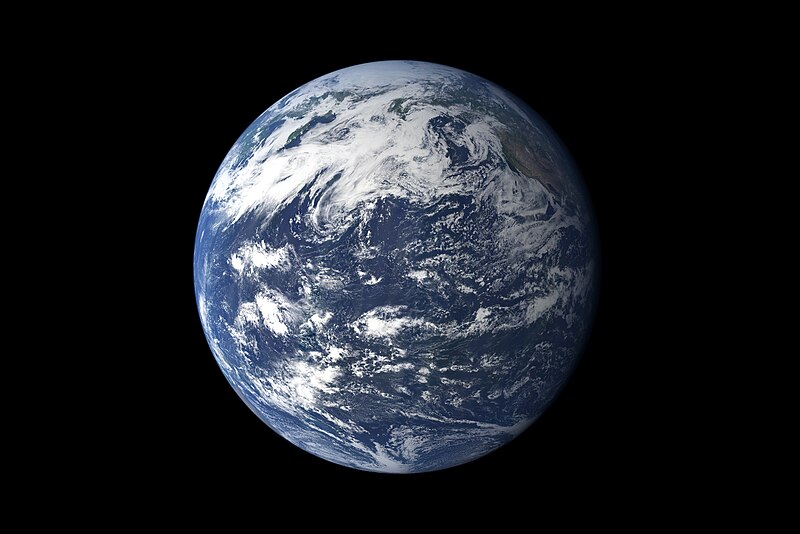File:Earth Pacific jul 30 2010.jpg

Archivo original (4096 × 2732 píxeles; tamaño de archivo: 1,25 MB; tipo MIME: image/jpeg)
Leyendas
Leyendas
Resumen[editar]
| DescripciónEarth Pacific jul 30 2010.jpg |
English: Viewed from space, the most striking feature of our planet is the water. In both liquid and frozen form, it covers 75% of the Earth’s surface. It fills the sky with clouds. Water is practically everywhere on Earth, from inside the rocky crust to inside our cells.
This detailed, photo-like view of Earth is based largely on observations from the Moderate Resolution Imaging Spectroradiometer (MODIS) on NASA’s Terra satellite. It is one of many images of our watery world featured in a new story examining water in all of its forms and functions. Here is an excerpt: “In all, the Earth’s water content is about 1.39 billion cubic kilometers (331 million cubic miles), with the bulk of it, about 96.5%, being in the global oceans. As for the rest, approximately 1.7% is stored in the polar icecaps, glaciers, and permanent snow, and another 1.7% is stored in groundwater, lakes, rivers, streams, and soil. Only a thousandth of 1% of the water on Earth exists as water vapor in the atmosphere. Despite its small amount, this water vapor has a huge influence on the planet. Water vapor is a powerful greenhouse gas, and it is a major driver of the Earth’s weather and climate as it travels around the globe, transporting heat with it. For human needs, the amount of freshwater for drinking and agriculture is particularly important. Freshwater exists in lakes, rivers, groundwater, and frozen as snow and ice. Estimates of groundwater are particularly difficult to make, and they vary widely. Groundwater may constitute anywhere from approximately 22 to 30% of fresh water, with ice accounting for most of the remaining 78 to 70%.” |
| Fecha | |
| Fuente | http://earthobservatory.nasa.gov/IOTD/view.php?id=46209 |
| Autor | NASA image by Robert Simmon and Marit Jentoft-Nilsen, based on MODIS data. |
Licencia[editar]
| Public domainPublic domainfalsefalse |
| Este archivo es de dominio público porque fue creado por la NASA. Las políticas sobre copyright de la NASA estipulan que «el material de la NASA no está protegido con copyright a menos que se indique lo contrario». (Políticas sobre copyright de la NASA o Políticas sobre la utilización de imágenes del Jet Propulsion Laboratory). |  | |
 |
Advertencias:
|
Historial del archivo
Haz clic sobre una fecha y hora para ver el archivo tal como apareció en ese momento.
| Fecha y hora | Miniatura | Dimensiones | Usuario | Comentario | |
|---|---|---|---|---|---|
| actual | 05:00 2 oct 2010 |  | 4096 × 2732 (1,25 MB) | Supportstorm (discusión | contribs.) | {{Information |Description={{en|1=Viewed from space, the most striking feature of our planet is the water. In both liquid and frozen form, it covers 75% of the Earth’s surface. It fills the sky with clouds. Water is practically everywhere on Earth, from |
No puedes sobrescribir este archivo.
Usos del archivo
La siguiente página usa este archivo:
Uso global del archivo
Las wikis siguientes utilizan este archivo:
- Uso en beta.wikiversity.org
- Uso en en.wikipedia.org
- Uso en en.wikiquote.org
- Uso en en.wikiversity.org
- User:Marshallsumter/Keynote lectures (draft)/Geology
- Draft:Original research/Radiation astronomy
- User:Marshallsumter/Radiation astronomy/Blues
- User:Marshallsumter/Radiation astronomy/Chemistry
- User:Marshallsumter/Radiation astronomy1/Objects
- Draft:Original research/Planets
- User:Marshallsumter/Radiation astronomy/Blues/Quiz
- Stars/Sun/Astronomy/Quiz
- Object astronomy
- Liquids/Liquid objects/Astronomy
- User:Marshallsumter/Radiation astronomy/Courses/Principles/Hourly 2
- User:Marshallsumter/Radiation astronomy/Courses/Principles/Final quiz
- Stars/Solar systems/Quiz
- Liquids/Liquid objects
- Draft:Enceladus/Quiz
- User:Marshallsumter/Radiation astronomy/Colors/Quiz
- User:Marshallsumter/Radiation astronomy1/Planets
- Portal:Radiation astronomy/Quiz
- Portal:Radiation astronomy/Quiz/2
- Stars/Blues/Quiz
- Draft:Dione/Quiz
- Radiation/Astronomy
- Uso en ja.wikipedia.org
Metadatos
Este archivo contiene información adicional, probablemente añadida por la cámara digital o el escáner usado para crearlo o digitalizarlo.
Si el archivo ha sido modificado desde su estado original, pueden haberse perdido algunos detalles.
| Orientación | Normal |
|---|---|
| Resolución horizontal | 72 ppp |
| Resolución vertical | 72 ppp |
| Software usado | Adobe Photoshop 7.0 |
| Fecha y hora de modificación del archivo | 23:55 1 oct 2010 |
| Espacio de color | sRGB |